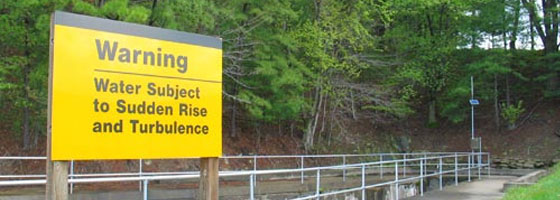Hydrogen Sulfide Monitoring – US Army Corps of Engineers

Project Overview
NexSens field engineers installed hydrogen sulfide monitoring systems with real-time radio telemetry at several reservoirs in northeast Ohio, where many of the reservoirs have become problem areas for emitting H2S gases as a result of improper restoration of strip-mined land prior to the Surface Mining Control and Reclamation Act of 1977.
Hydrogen sulfide (H2S), a colorless, flammable gas that smells like rotten eggs, is a hazardous substance to both people and the environment. When exposed to even low levels of hydrogen sulfide gas, people can experience eye irritation, a sore throat and cough, shortness of breath, and fluid in the lungs.
H2S gas is commonly formed during warm weather when runoff from coal mines with high sulfate concentrations mix with water from lake bottoms.
Hydrogen sulfide problems currently exist at Tappan, Atwood, Leesville, Piedmont and Clendening reservoirs. Warning signs have been posted in several areas advising the public to stay away. The US Army Corps of Engineers (USACE) has studied the issue at length and has identified solutions that should minimize and/or eliminate the problems. The USACE contacted NexSens Technology to install permanent hydrogen sulfide detectors at each of the problem areas.
Monitoring System Description
Each system was installed at the reservoir’s concrete outlet tunnel, where water with high hydrogen sulfide concentrations is routinely released.
Each system consists of a NexSens 4100-iSIC data logger mounted inside a lockable stainless steel enclosure. A 26 A-hr battery is also housed within the enclosure to power the data logger, and NexSens A22 Solar Panel Kits continuously charge the battery. At user-specified intervals throughout the day, data from each site is transmitted via license-free radio waves to a nearby 4100-BASE radio base station.
 Located within the NexSens AVSS241608 Stainless Steel Enclosures, ATI Q45S Wet Hydrogen Sulfide Gas Monitors continuously monitor H2S levels. The Q45S wet H2S gas detector uses the standard Q45 electronics package in conjunction with a special “Wet H2S” sensor. The sensor data is output to the NexSens 4100-iSIC data logger via 4-20mA signal that is linearly proportional to H2S gas concentration.
Located within the NexSens AVSS241608 Stainless Steel Enclosures, ATI Q45S Wet Hydrogen Sulfide Gas Monitors continuously monitor H2S levels. The Q45S wet H2S gas detector uses the standard Q45 electronics package in conjunction with a special “Wet H2S” sensor. The sensor data is output to the NexSens 4100-iSIC data logger via 4-20mA signal that is linearly proportional to H2S gas concentration.
Wireless real-time data transmission allows USACE personnel to know H2S levels without entering the potentially dangerous area with a handheld meter. At low concentrations (less than 10-20ppm) the gas has a rotten egg odor. However in greater concentrations (150-250ppm or greater) the gas loses its smell and can go undetected, which means there is no warning sign of the eminent danger.
NexSens Technology field engineers have been servicing the USACE sites since their installation in spring 2003. In 2007, the USACE renewed a 5-year contract for our field engineers to continue servicing the sites, lasting until 2011. The H2S monitoring sites are maintained from May to October with monthly site visits for calibration and inspection. Data is also available on NexSens’ WQData web datacenter in real-time to monitor any problems that may appear between site visits.




0 comments